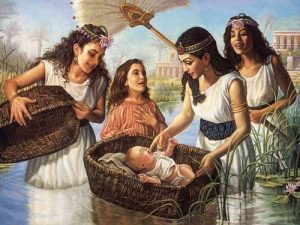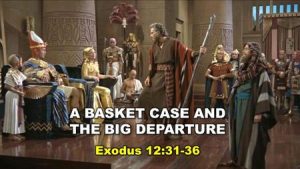
Shownotes
Wisdom-Trek / Creating a Legacy
Welcome to Day 836 of our Wisdom-Trek, and thank you for joining me.
I am Guthrie Chamberlain, Your Guide to Wisdom
The Abandoned Child Is a Basket Case – Wisdom Wednesday

Today is Day 836 of our trek, and it is Wisdom Wednesday. The past several months on Wednesday we have been focusing on interpreting current events through a Biblical worldview. To establish a Biblical worldview, it is important that you also have a proper understanding of God’s Word.
Especially in our western cultures, we do not fully understand the Scriptures from the mindset and culture of the authors. In order to help us all have a better understanding of God’s Word, we are investing the next several months on Wednesday reviewing a series of essays from one of today’s most prominent Hebrew Scholars Dr. Micheal S. Heiser, which he has compiled into a book titled I Dare You Not to Bore Me with the Bible.
We are broadcasting from our studio at The Big House in Marietta, Ohio. Being abandoned as a child is one of the worst things that can happen to a person. That abandonment can include both physical and emotional abandonment. It would make most of us a basket case as adults. As we continue to explore the Old Testament from the time frame and culture in which it was written, the topic of our essay today is…
The Abandoned Child Is a Basket Case

In modern stories, people destined for greatness rarely start off privileged. They are dropped off at the doorstep of an orphanage or abandoned in the rain. This literary motif goes back to ancient stories, where writers use the abandoned child theme to identify a character that rises from obscurity to privileged hero status. It’s a motif found in the biblical account of Moses’ birth. But is that really the whole story?
Moses’ story begins when Pharaoh feels threatened by the growing Hebrew population in Egypt and commands that all Hebrew male infants be killed. This narrative is found in Exodus [1:16]-22. Moses’ mother hides her newborn son for three months and then devises a risky but calculated plan: She sets him adrift on the Nile in a small basket made of papyrus reeds, waterproofed with tar and pitch as described in Exodus 2:1-3.
About this time, a man, and woman from the tribe of Levi got married. The woman became pregnant and gave birth to a son. She saw that he was a special baby and kept him hidden for three months. But when she could no longer hide him, she got a basket made of papyrus reeds and waterproofed it with tar and pitch. She put the baby in the basket and laid it among the reeds along the bank of the Nile River.

Moses’ older sister, Miriam, watches as the basket floats to where the daughter of Pharaoh bathes. God uses these circumstances to bring Moses under the protection of Egypt’s ruler portrayed in Exodus 2:4-10.
Ancient literature outside the Bible attests to several stories in which a child, perceived as a threat by an enemy, is abandoned and later spared by divine intervention or otherworldly circumstance. Roughly 30 stories like this survive from the literature of ancient Mesopotamia, Canaan, Greece, Egypt, Rome, and India.
The Mesopotamian work known as the Sargon Birth Legend offers the most striking parallels to the biblical story. It relates the birth story of Sargon the Great, an Akkadian emperor who ruled a number of Sumerian city-states around 2000 BC, centuries before the time of Moses. The infant boy is born into great peril: His mother is a high priestess, and he is illegitimate. Consequently, his mother sets him adrift on a river in a reed basket. The boy is rescued and raised by a gardener named Akki in the town of Kish. He becomes a humble gardener in Akki’s service until the goddess Ishtar takes an interest in him, setting him on the path to kingship.
Some assume that the biblical story of Moses birth was based on the Sargon Birth Legend, but this is unlikely. Although ancient Sumerian accounts of Sargon the Great date back to his lifetime, the legendary account of his birth is known from only four fragmentary tablets—three from the Neo-Assyrian period (934-605 BC) and one from the Neo-Babylonian period (626-539 BC).
During the Neo-Assyrian period, an Assyrian king took the name Sargon II and likely commanded the legends to be written about his namesake (722-705 BC). In doing so, he would have linked himself to the ancient hero and glorified himself as a “revived” Sargon figure. This would suggest that the birth legend was composed for propaganda purposes well after the biblical story of Moses.
The existence of stories like the Sargon Birth Legend helps us understand the biblical story. They show that the abandoned child theme was a popular literary strategy for the ancients. They used it to introduce a figure who rises from mundane origins after gaining favor from fate or the divine. The common elements in these rags-to-riches stories helped ancient audiences identify with the central figure and develop respect for his achievements.
Moses’ story is about more than parallels, though. While Moses briefly seems to find favor and protection in the household of Pharaoh, a quasi-divine figure for the Egyptians, his life takes a surprising turn. He ends up leaving the kingdom of Egypt fearing that Pharaoh will kill him. From there, the story is re-patterned: In a wilderness of Midian, Yahweh appears to Moses, who is now an obscure shepherd and he describes himself in Exodus 4:10 in this manner. “But Moses pleaded with the Lord, ‘O Lord, I’m not very good with words. I never have been, and I’m not now, even though you have spoken to me. I get tongue-tied, and my words get tangled.'” Regardless, God tells Moses to act as His spokesperson before Pharaoh and lead His people out of Egypt.

Moses stands out against the stories of the ancient cultures because he isn’t promoted like their chosen figures, but saved and demoted to poverty so that he can lead others to salvation. He is the new archetype of the chosen hero, one who is promoted only for the benefit of others. Over and against the stories of worldly kingdoms, Moses’ story articulates God’s remarkable work for His kingdom. His values are different from ours, and as is often the case in retrospect, we can be grateful for that.
Next Wisdom Wednesday we will continue with Moses as we look at Dr. Heiser’s next essay titled “A Tale of Courage We Never Teach.” I believe you will find this another interesting topic to consider as we build our Biblical Worldview.
Tomorrow we will continue with our 3-minute wisdom nugget that will provide you with a bit of wisdom that, if followed will allow you to grow healthier, wealthier and wiser each day. So encourage your friends and family to join us and then come along with us tomorrow for another day of our Wisdom-Trek, Creating a Legacy.

That will finish our trek for today. If you would like to listen to any of our past 835 treks or read the Wisdom Journal, they are available at Wisdom-Trek.com. I encourage you to subscribe to Apple Podcast or Google Play so that each day’s trek will be downloaded automatically.
Thank you for allowing me to be your guide, mentor and most of all your friend as I serve you through the Wisdom-Trek podcast and journal.
As we take this trek together, let us always:
- Live Abundantly (Fully)
- Love Unconditionally
- Listen Intentionally
- Learn Continuously
- Lend to others Generously
- Lead with Integrity
- Leave a Living Legacy Each Day
I am Guthrie Chamberlain reminding you to Keep Moving Forward, Enjoy Your Journey, and Create a Great Day Everyday! See you tomorrow!